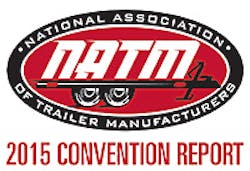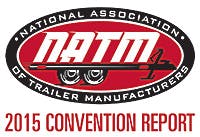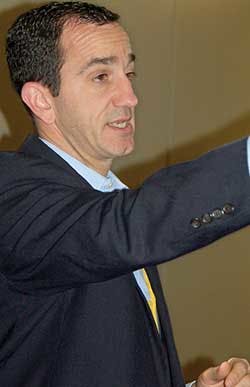McGladrey survey shows that 22% are ‘very optimistic’ about growth in 2015—6% more than companies in the general economy
TRAILER manufacturers are more optimistic than companies in the general economy about growth prospects for 2015, according to a survey by McGladrey LLP.
The survey showed that 22% of the companies in the trailer industry are very optimistic, compared to 16% in the general economy, and 63% of those in the trailer industry are somewhat optimistic, compared to 72% in the general economy.
“I think we’re all getting the feeling and sense that 2015 is going to be a good year,” said Joe Cataldo, assurance partner at McGladrey. “Things look promising as we look forward.”
Industry benchmarks from 2013 showed 64% growth for trailers (open, cargo, livestock, and aluminum) and 80% growth for assemble-to-order manufacturers (RV, ambulance, fire trucks, other specialty vehicles).
Talking about the lack of qualified employees, he said, “There are pockets of the country where it’s not a huge issue. But where we are (Indiana), it’s a huge issue. There are just not enough able, willing bodies around to meet the increased demand we’re seeing in marketplace.”
The survey showed that so far in 2015, 49% believe business is holding its own (the same as in 2014), but 41% said it’s thriving (a 3% decline from 2014).
“No real surprises there,” Cataldo said.
The 2013 trailer industry benchmarks were 16% top-line revenue growth for trailers (compared to 25% in 2012) and 21% for assemble-to-order manufacturers, and he said 2014 revenue growth was 15% to 20% for trailers.
“I imagine most of you are seeing that,” he said. “There is extra money people have in their pockets. The lower end, less complex product continues to be in highest demand, and the highest growth rates are in the higher end product. The whole economy is doing well, so people are feeling comfortable and more confident that the higher end product that might not have been in the cards before is going to be a possibility.”
He said 50% of respondents increased sales prices in 2014, all of them at between 1% and 5%.
Cataldo said the US economy’s strength is expected to continue into early 2016, led by lower oil and gas prices.
“That’s a game-changer of sorts,” he said. “It should ripple through the economy, with an estimated $2200 per household in additional disposable income. It will put extra money in their pockets and enhance their discretionary spending. The benefits should outweigh the costs to the economy. Obviously, some production facilities are shutting down and aren’t able to make money at those lower amounts.”
He said the manufacturing sector will continue to improve, with a reversal of jobs/products manufactured overseas, a strong dollar, increased US government spending, and minimal movement with US government policies.
He said his sense from the survey is that few trailer manufacturers are selling to markets around the world, but those that are need to keep an eye on market conditions.
“2014 was uneven at best,” he said. “The Canadian economy is slowing. The Chinese economy is slowing as the workforce there is getting a taste of wages and China is not as price-competitive in the global marketplace as it used to be. Europe is in trouble, with the economy slowing, except Germany. There are deflationary concerns that the EU Central Bank is attempting to shore up.”
He said we should expect an oil and gas correction over the next 18 months.
“What will Saudi Arabia do?” he said. “There’s political instability in the Middle East. We don’t know what’s going to occur there. There is expected movement up to between $70 and $80 per barrel over the next 18 months, and that will hopefully be the new norm of prices. It will be impacted by a supply slowdown in the second half of 2015. The US is now the price maker in terms of pricing instead of the price taker. So that’s another good thing we’re excited about.”
Lending is back to pre-recession levels, with banks taking more chances with OEMs and floor plans available for most dealers and manufacturers.
“There is improvement, but dealers and customers still control the buying cycle,” he said. “Dealer loyalty is still lacking compared to other industries. End customers are buying on price, not brand. Manufacturers are having trouble getting past the commodity label.”
Based on the survey, 33% of trailer manufacturers are expecting 1% to 10% growth in 2015, with 42% expecting 11% to 20% growth, and 17% expecting 20%-plus growth. McGladrey’s expectation is 10%.
He said 93% of respondents are greatly or somewhat relying on increased product offerings, 100% are greatly or somewhat relying on increased sales to current customers, and 92% greatly or somewhat relying on the acquisition of new customers (compared to 97% in 2014).
“There is increased opportunity for dealer floor plan arrangements, but the percentage use by the trailer industry lags behind other industries,” he said. “For traditional sales, 31% are on COD terms, 69% on one- to 30-day terms, and 0% on 30-plus-day terms.
“There is increased opportunity for OEM differentiation through targeted dealer programs, with 14% of respondents using interest-reimbursement programs, compared to 8% in 2014, and 8% of respondents using volume-rebate programs, and 43% of respondents using discounting programs. There are important margin considerations from these programs.
“In terms of dealer-loyalty considerations, 85% of respondents indicated that product quality is important to dealer loyalty, 38% indicated that brand name is important to dealer loyalty, and 54% indicated that product price is important to dealer loyalty.”
There are cost-structure considerations involving energy, raw materials, outbound freight, cost of debt, wages, and employee benefits. The survey showed that 49% believe that raw materials will increase in cost by between 1% and 10%.
“Inventory pricing retracted slightly in 2014, for the third year in a row, with 2013 materials to sales of 59.6% as an industry benchmark.”
Aluminum and steel inventories remain high.
“There is lower demand, with the slowing economies in China and Europe,” he said. “There are new plants and increased capacity over the past few years, especially in China. Capacity beginning to respond, but not in time to impact inventories. Consumption in the US will remain higher than the rest of the world, with the auto market and construction industries leading the way. Expect prices to remain at flat to small declines.
“Foreign sourcing continues to lag behind other industries, with 50% of respondents using foreign-sourced raw materials and 82% of respondents decreasing foreign-sourced materials. There are growing inventory levels, with 85% of respondents expecting to increase inventory levels by 1% to 20%.”
Cataldo said employee productivity remains at a high level: The average employee generated $204,000 of revenue annually as a 2013 industry benchmark. Employee fatigue and growth led to increased employee levels in 2014. Employee and skill shortages continue: 50% of respondents indicated that they were able to find skilled talent only some of the time or rarely, and 100% indicated that a workforce skills gap led to decreased productivity.”
Potential pitfalls:
• Regulatory uncertainty. “The impact of income inequality and middle-class redistribution rhetoric.”
• The expected first real wage growth in some time. “It should be 2% to 4% in 2015.”
• The labor participation rate will continue to decline. “The impact of those no longer working and Baby Boomer retirement. There is a significant skills erosion of workers out of workforce for 27 weeks or more.”
• Labor shortages in skilled and semi-skilled positions. “The US will need to begin importing workers. That requires immigration reform, which is doubtful with the current political environment.”
He said that manufacturers generally need a paradigm shift because manufacturing is not glamorous. There should be a focus on worker preferences and training.
To attract new employees, 45% of respondents are increasing compensation (base or incentive), and 18% are focusing on quality-of-life matters. Twenty-seven percent of respondents are not attracting new employees and are using overtime to compensate for lack of quality employees.
Health benefits remain a large component of a company’s cost structure. The majority of respondents are fully insured (55%), with almost 29% not offering it or offer it only to management.
Coverage levels: 17% cover 41% to 60% of premiums; 25% cover 61% to 80% of premiums; and 25% cover 81% or more of premiums.
Future costs: 42% predicted less than a 10% increase in 2014; 50% predicted a 10% to 19% increase; and 8% predicted a 20% or more increase.
Cataldo said 58% of respondents have debt, compared to 87% in 2014. The majority of respondents are not using interest rate swap features to control interest rates. The majority of respondents have financial covenants (38%), a borrowing base (50%), guarantees (50%), and external financial statement requirements (100%).
Other matters:
• 75% of respondents plan to expand capacity in 2015 (compared to 53% in 2014)
• 17% of respondents reported a data breach in the past 12 months.
• Factors that most contributed to improving productivity: process improvements (73%); labor utilization (46%, compared to 62% in 2012); investment in and utilization of equipment (39%); and training (34%). ♦
About the Author
Rick Weber
Associate Editor
Rick Weber has been an associate editor for Trailer/Body Builders since February 2000. A national award-winning sportswriter, he covered the Miami Dolphins for the Fort Myers News-Press following service with publications in California and Australia. He is a graduate of Penn State University.


